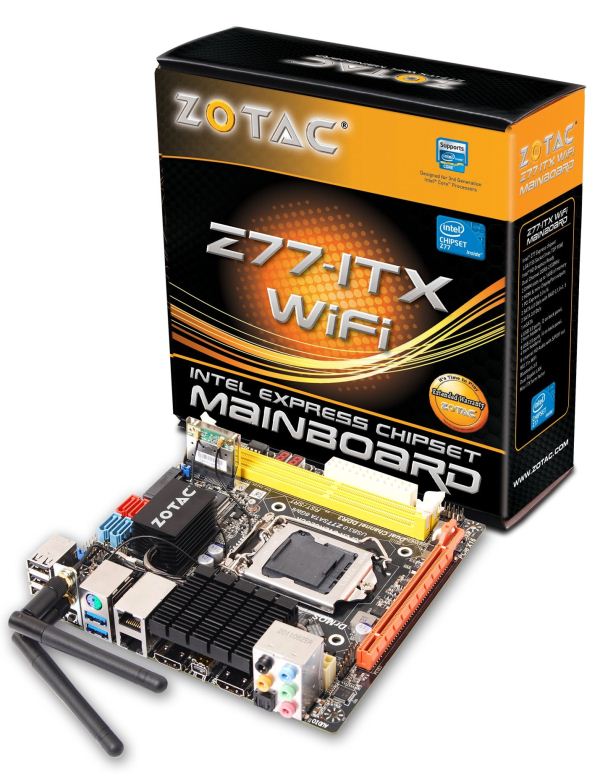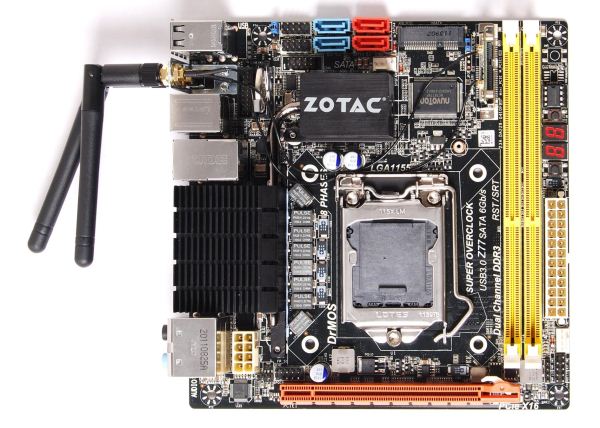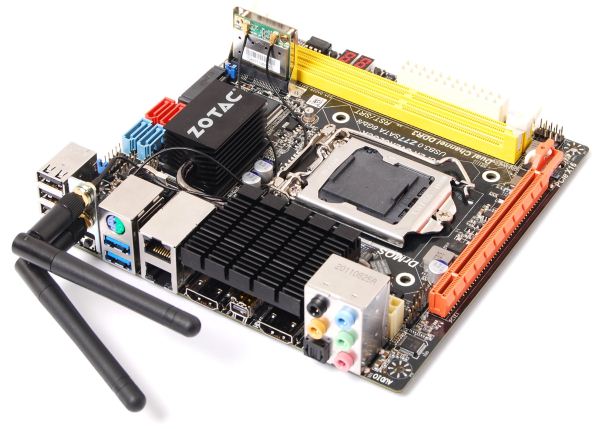Z77 mITX Round-Up: Five of the Best – MSI, Zotac, ASRock, EVGA and ASUS
by Ian Cutress on December 31, 2012 7:00 AM EST- Posted in
- Motherboards
- MSI
- ASRock
- EVGA
- ZOTAC
- Asus
- Ivy Bridge
- Z77
- mITX
Zotac
If you ever wanted small form factor, then Zotac has always been an option, sprouting mITX products for every platform and chipset. With Ivy Bridge and 7-series platforms, Zotac has announced three products so far – two H77 motherboards (-A-E and -B-E), and this motherboard, the Z77-ITX WiFi (also known as the Z77-A-E).
Historically Zotac has not had the ability to innovate as much as the key players in the motherboard industry. Part of this is down to the 'real estate on the PCB of a mITX' factor – the chipset specification deals with a significant amount of the actual hardware on board, but part of it is also due to the size of the company in correlation to their R&D. In this context Zotac fit in the same niche as Biostar – whatever we do see in terms of innovation is few and far between. However every now and again we are pleasantly surprised, as long as it fits into the correct price bracket.
With that, let us start with the Z77-ITX WiFi.
Zotac Z77-ITX WIFI Overview
When testing the Zotac Z77-ITX, I initially ran through the benchmark suite with a high end i7-3770K, and again recently with an i3-3225. In terms of performance, there were several key factors worth noting, such as the slightly slower times in our WinRAR testing compared to other Z77 products. This test relies on the motherboard to apply turbo multipliers given varied load – it is a test that top tier manufacturers seem to do well in, but the lesser manufacturers fall behind. On the plus side, we get a fast POST time (9.18 seconds with a discrete GPU installed), low power usage (20W long idle on a 500W Platinum PSU with a discrete GPU installed, 32W idle) and a sub-200 microsecond DPC Latency test.
Hardware wise, Zotac take a different tack to the video outputs compared to the rest of the Z77 crowd. The Z77 platform with an Ivy Bridge processor allows for 3 digital display outputs and one analogue; most motherboard vendors take this to mean ‘we want one of each output’. Zotac, like Gigabyte, decided to make two of these outputs HDMI to cater for the majority of dual screen home setups (or to supply audio out of one and video out of the other). Rather than give a combination DVI-I port, Zotac also equipped the board with a mDP port and placed in the package a mDP to DP adaptor. If you want a modern digital connection from a Z77 mITX board, Zotac has you covered.
Also relating to hardware, Zotac have given this board a dual NIC as well as WiFi on board, giving network connectivity a high priority. On the downside, we only get a Realtek ALC889, which also failed our RMAA 192 kHz test. The USB 2.0 copy times were quite low, but improved while the CPU was under load, suggesting that some of the BIOS default options are not optimal for USB transfer. The big BIOS option faux pas however is the reluctance for Zotac to move into 2012 and enable AHCI on their SATA ports by default. Also, if you were looking for software for OC or fan control software, unfortunately you will not find them on a Zotac board.
The Zotac Z77-ITX is currently fluctuating wildly in price. When I started the testing for this review, it was at $130. I now see it on Newegg for $163. For the former, it warrants a consideration when weighing up the pros and cons between which Z77 mITX motherboard to choose – having all those extras in the box helps sweeten the deal if you can overlook some of the possible issues.
Visual Inspection
As one of the first Z77 ITX motherboard on the test bed, it is hard not to notice the arrangement of the motherboard as a whole. The location of the socket is very close to the PCIe connector – with the limitations of the mITX platform, the Intel minimum specified distance of components away from the socket (marked by the white box around the socket) is adhered to but only just. This comes into play when we deal with different air coolers on such a platform.
Typically with a Z77 motherboard we see the chipset and additional IO chips to the south of the memory slots, but there is no such luxury on the Zotac Z77-ITX WiFi – we have the chipset located above the CPU, along with our SATA connectivity. In terms of SATA ports, Zotac uses the two SATA 6 Gbps and two SATA 3 Gbps from the chipset for direct SATA connections – another of the SATA 3 Gbps from the chipset is used for the mSATA port to the right of the SATA ports. This should leave one more for an eSATA port on the back IO, but we find no eSATA port.
Fan headers on board are oddly positioned – with a mITX platform I would expect at least two, if not three, and we get two 4-pin headers here. We find a CPU header on the right hand side below the 24-pin ATX power connector and a 4-pin SYS header between the chipset heatsink and the SATA ports. A lot of the space on the right hand side is taken up by the full length DDR3 memory slots – in the past we have seen Zotac switch them out for SO-DIMM memory ports, which could always be an idea for this platform (or if possible, angled SO-DIMM on the back of the board (?)).
The heatsink arrangement for the Zotac covers the chipset above the socket, and the VRM. Zotac have decided to extend the heatsink over the IO panel due to their back panel port arrangement. Even with the fan headers, this should help with cooling if the system were to be pushed with a high wattage chip and an overclock.
The location of the 8-pin CPU power connector is a little odd – we find it on the bottom of the board below the heatsink for the power delivery. This means that any power supply would need to reach over parts of the board in order to connect in. Zotac get around this by including an 8-pin CPU power extension cable in the box, but that still leaves the fact that a cable is somewhere potentially blocking airflow.
Other features directly visible on the board are the mSATA port and the WiFi module, both located above the CPU socket and to the right. The WiFi card is perpendicular to the board itself, and runs two small cables to antenna ports on the back panel – I personally found these cables a little annoying when trying to plug peripherals in to the ports when the board was fixed in a case.
The mSATA port is something that will crop up on mITX boards from now on, providing the possibility of running a smaller form factor if you want to pick up an mSATA SSD. As mSATA densities get higher, this will become more viable for Windows users (where Windows 7 x64 Ultimate requires a drive more than 32GB).
Also on board are various headers for the front panel, the front panel audio, two USB 2.0 headers, a USB 3.0 header (found near the IO), a two-digit debug LED and power and reset buttons. The location of the USB 3.0 header is strange, as in a mITX platform it would more likely be for a front case connector or a separate USB 3.0 panel. It is nice to see a debug LED on board however – I did have to use it a couple of times to determine why the board was failing to boot.
On the back panel, the IO is slightly odd compared to other Z77 motherboards we have encountered. First up is a block of four USB 2.0 ports (I like blocks like this as it gets a lot of USB connectivity sorted), a pair of antenna slots, a ClearCMOS button, a PS/2 combination port, two USB 3.0, dual Realtek NIC, dual HDMI, mini-DP, optical S/PDIF output and audio jacks. The dual HDMI is an interesting addition, as it involves in internal conversion from the DVI port to a HDMI. I wonder if there is scope for this on more mainstream Z77 motherboards, whereby video output is organized in a single IO stack of HDMI, mDP/DP, HDMI. Given our past reviews, the Gigabyte H77-ITX certainly has an inkling with their dual HDMI setup.
Board Features
| Zotac Z77-ITX | |
| Price | Link |
| Size | Mini ITX |
| CPU Interface | LGA-1155 |
| Chipset | Intel Z77 |
| Memory Slots |
Two DDR3 DIMM slots supporting up to 16 GB Up to Dual Channel, 1066-2133 MHz |
| Video Outputs |
2 x HDMI mDP |
| Onboard LAN |
2 x Realtek 8111E 1 x WiFi Module |
| Onboard Audio | Reaktek ALC889 |
| Expansion Slots |
1 x PCIe 3.0 x16 1 x mSATA 1 x mini-PCIe (occupied by WiFi module) |
| Onboard SATA/RAID |
2 x SATA 6 Gbps, Supporting RAID 0, 1, 5, 10 2 x SATA 3 Gbps, Supporting RAID 0, 1, 5, 10 1 x mSATA / mini-PCIe |
| USB |
4 x USB 3.0 (Chipset) [2 back panel, 2 onboard] 8 x USB 2.0 (Chipset) [4 back panel, 4 onboard] |
| Onboard |
2 x SATA 6 Gbps 2 x SATA 3 Gbps 1 x USB 3.0 Header 2 x USB 2.0 Headers 2 x Fan Headers 1 x mSATA / mini-PCIe 1 x Front Panel Audio Power/Reset Buttons Two-Digit LED Debug |
| Power Connectors |
1 x 24-pin ATX Power Connector 1 x 8-pin CPU Power Connector |
| Fan Headers |
1 x PWR (4-pin) 1 x SYS (4-pin) |
| IO Panel |
4 x USB 2.0 2 x Antenna 1 x Clear CMOS 1 x PS/2 Combination Port 2 x USB 3.0 2 x Realtek 8111E GbE 2 x HDMI 1 x mDP 1 x Optical SPDIF Output Audio Jacks |
| Warranty Period | 3 Years |
| Product Page | Link |
On the pure hardware side, apart from the arrangement of the socket area, we could call Zotac out on one or two design issues. The lack of an analogue output, even in the modern era, could be an oversight – this all comes down to the design of the package. We also only have the Realtek ALC889 audio codec, rather than the ALC89x series, and for some reason it fails the RMAA 192 kHz test. It is worthy of note however to mention the dual NIC + WiFi which is rare on a mITX board, as well as the presence of power/reset buttons in conjunction with a two-digit debug LED, useful for troubleshooting.














54 Comments
View All Comments
Etern205 - Saturday, January 5, 2013 - link
Here is another model, that supports WiDihttp://www.asus.com/Motherboards/Intel_Socket_1155...
zilexa - Friday, January 11, 2013 - link
Will the upcoming Intel CPUs with integrated GTe graphics chip fit on these mobo's? If so these mITX mobos are VERY futureproof and ideal for an HTPC.doubledd - Wednesday, April 10, 2013 - link
I recently built a mini itx with the MSI Z77IA-53, Cooler Master Elite 120, Antec Kuhler 620, 16gb 1.35V ballistic memory, a 690GTX, a 3570k, default timings and a msata plextor SSD. Except the video card, the system was dirt cheap. With the card, 3D Mark 11 score of X6037.Removal of the HDD cage was all that was required to make room for the radiator to mount to the existing front fan on this $45 case. Folding 100% load processor is 64 degrees....not great, but manageable for this BEAST.
While I consider Anandtech to be one of my trusted sources in reviews, I find it disappointing that they could be reviewing mini itx systems and yet be so out of touch with what people actually use these for. These are lan boxes or HTPCs and are supposed to be small and quiet. Why anyone would want a 8" tall by 8" diameter fan is beyond me. These boards are hardly bigger than a post card. Things are gonna be tight. Think out of the box a bit huh? There are quite a few mini-itx cases that can run or be modded with little effort to run, quiet liquid cooling.
It reminds me of the Consumer reports worst cars of 2013. Half of them are off road vehicles. The complaints are about suspension, shifting and road noise......no kidding?
castl3bravo - Sunday, June 23, 2013 - link
I have found the Asus BIOS for my P8Z77-I Deluxe to be an abysmal mess. My CPU ratio is permanently stuck at 42. During some change of a setting or an upgrade to the latest BIOS, ASUS shoved a "hidden" ME upgrade as well. This process somehow corrupted my BIOS so now I can't overclock beyond ratio of 42.There are other ASUS P8Z77 based m/b's having the same issue. I would suggest Anand have his team research the forums first before writing such glowing reviews of the BIOS for a vendor. I bought this board based on, what appears to be, an inexperienced review last year. Reading this followup on the BIOS is laughable--perhaps even negligent.
Here is but one example of the drama people are going through with this messed up BIOS.:
http://forums.anandtech.com/showthread.php?t=23143...